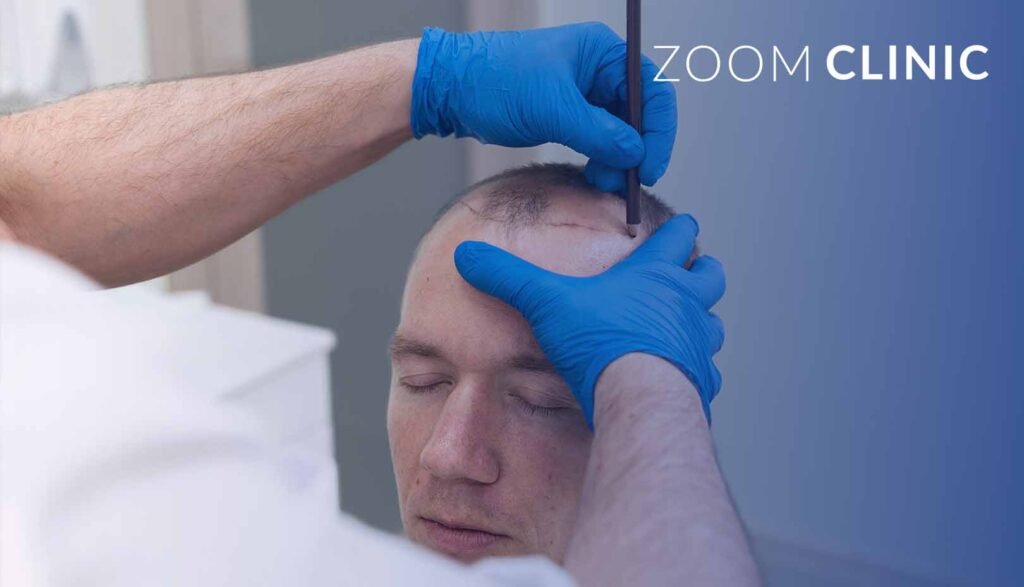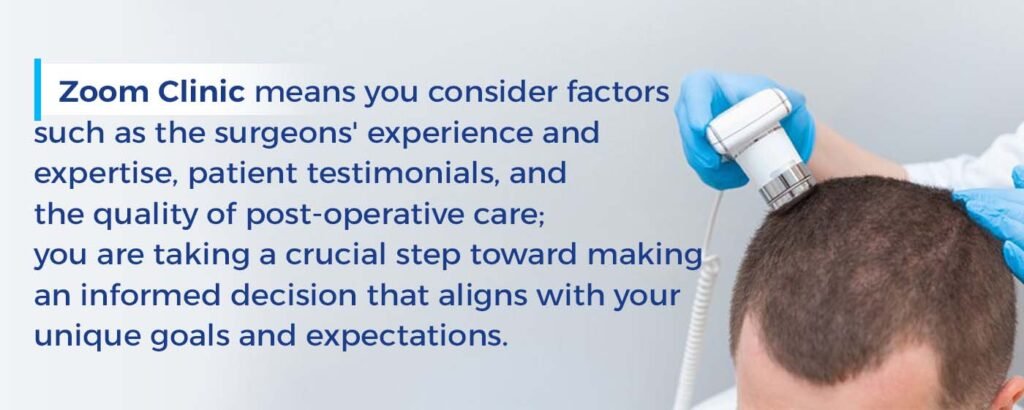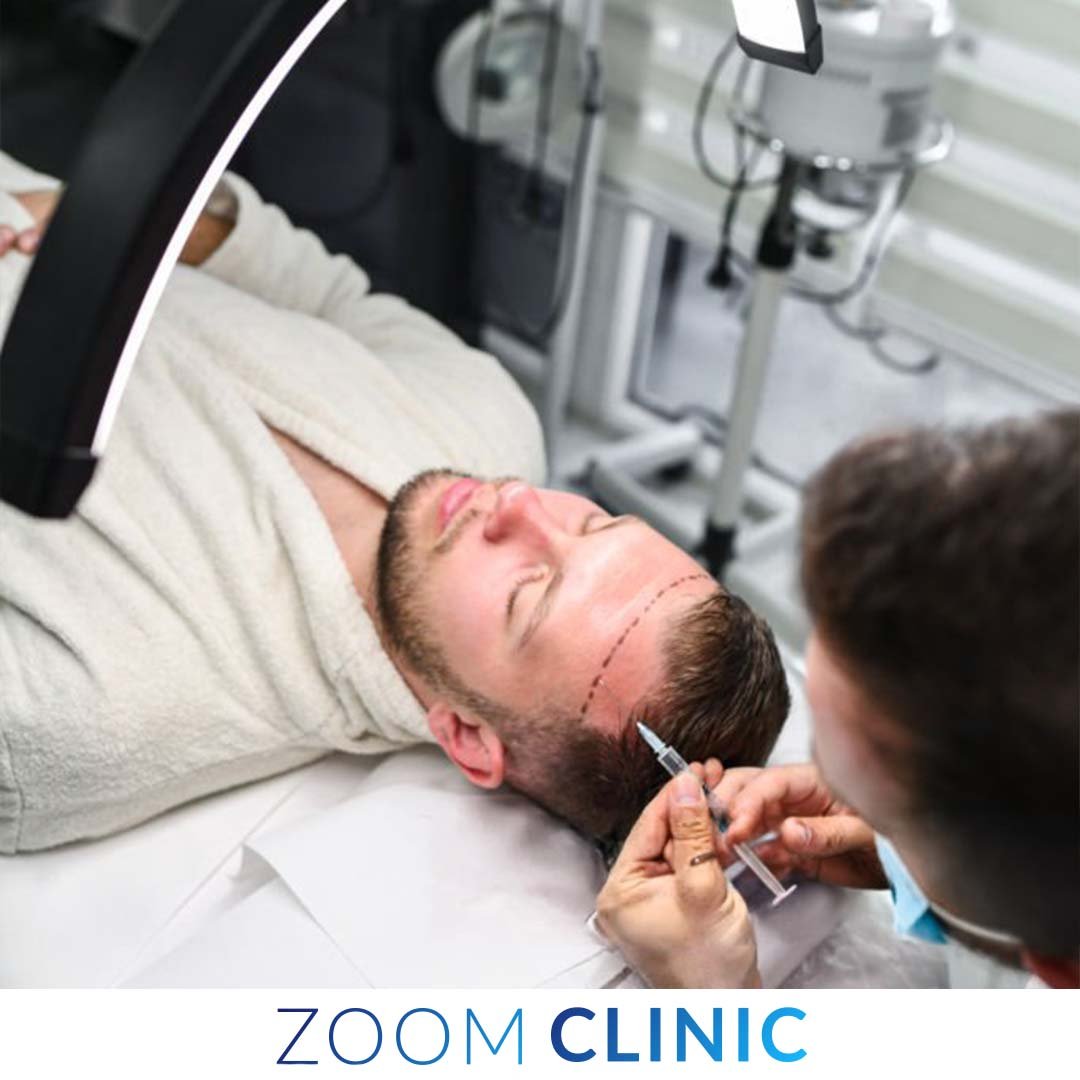Undergoing a hair transplant is a significant step in addressing hair loss and regaining your self-esteem.
Preparing adequately for your hair transplant procedure can significantly influence the outcome and overall experience.
This comprehensive guide will walk you through the necessary steps to ensure you are well-prepared for your hair transplant journey.
Table of content
Understanding Hair Transplants
What is a Hair Transplant?
A hair transplant is a surgical procedure that involves moving hair follicles from one part of the body, known as the donor area, to a bald or thinning part, called the recipient area.
This procedure is primarily used to treat male pattern baldness, but it can also be used to restore eyelashes, eyebrows, and beard hair and to fill in scars caused by accidents or surgeries.
Types of Hair Transplants
There are two main types of hair transplant procedures: Follicular Unit Transplantation (FUT) and Follicular Unit Extraction (FUE).
Follicular Unit Transplantation (FUT)
In FUT, a strip of skin containing hair follicles is removed from the donor area, usually the back of the head, and divided into individual grafts.
These grafts are then transplanted into the recipient area. This method leaves a linear scar but allows transplanting many grafts in one session.
Follicular Unit Extraction (FUE)
FUE involves extracting individual hair follicles directly from the donor area and transplanting them to the recipient area.
This method does not leave a linear scar; the recovery time is usually shorter than FUT. FUE is often preferred for its minimally invasive nature and natural-looking results.
Preparing for Your Hair Transplant

Initial Consultation
The first step in preparing for your hair transplant is to schedule an initial consultation with an experienced surgeon.
During this consultation, your surgeon will assess your hair loss pattern, examine your scalp, and discuss your medical history. This is also the time to discuss your expectations and desired outcomes.
Medical Evaluation
A thorough medical evaluation is essential to identify underlying conditions that might affect the surgery or recovery process.
Inform your surgeon about any medical conditions, such as diabetes or high blood pressure, and any medications you take, including blood thinners, beta-blockers, and anti-inflammatory medications.
Pre-Operative Instructions
Your surgeon will provide specific instructions to follow in the weeks leading up to your hair transplant. Adhering to these guidelines is crucial for a successful outcome and minimizing potential complications.
Avoid Blood Thinning Medicines
One week before the procedure, avoid taking blood-thinning medicines such as aspirin and ibuprofen, as they can increase bleeding during surgery.
If you are on prescription blood thinners, consult your doctor about safely discontinuing their use before the surgery.
Quit Smoking
Smoking can impair blood flow and delay the healing process. It is recommended to quit smoking at least two weeks before and after the surgery to ensure optimal blood flow to the transplanted grafts and minimize the risk of complications.
Avoid Alcohol and Caffeine
Alcohol and caffeine can dehydrate your body and affect the healing process. Avoid consuming alcohol and caffeine for at least three days before the surgery.
Follow a Healthy Diet
Maintaining a healthy diet rich in vitamins and minerals can promote hair health and improve overall well-being. Ensure you are well-nourished and hydrated in the days leading up to your surgery.
Day of Surgery
On the day of your hair transplant, following your surgeon’s instructions closely is essential to ensure a smooth procedure and recovery.
Wash Your Hair
Wash your hair thoroughly with a mild shampoo on the morning of the surgery. This helps remove any dirt and oil from your scalp, reducing the risk of infection.
Wear Comfortable Clothing
Wear comfortable, loose-fitting clothing, preferably with a button-down shirt, to avoid disturbing the surgical area when changing clothes.
Arrange for Transportation
Arrange for someone to drive you to and from the clinic on the day of the surgery, as you may feel groggy from the local anesthesia and the procedure itself.
The Hair Transplant Procedure
Understanding the steps involved in the hair transplant procedure can help alleviate anxiety and ensure you know what to expect.
Local Anesthesia
The procedure begins with the administration of local anesthesia to numb the donor and recipient areas. This ensures a pain-free experience during the surgery.
Harvesting Hair Follicles
Depending on the chosen method (FUT or FUE), hair follicles are harvested from the donor area. In FUT, a strip of skin is removed and dissected into individual grafts.
In FUE, individual hair follicles are extracted directly from the scalp.
Preparing the Recipient Area
The surgeon makes tiny incisions in the recipient area where the hair follicles will be transplanted. These incisions’ angle, direction, and density are carefully planned to ensure natural-looking results.
Transplanting Hair Follicles
The harvested hair follicles are meticulously transplanted into the recipient area. This process requires precision and expertise to achieve a successful outcome.
Post-Operative Care
Proper post-operative care is crucial for the success of your hair transplant and the overall healing process.
Immediate Aftercare
After the procedure, your surgeon will provide detailed instructions on how to care for your scalp. This may include:
- Avoid touching or scratching the transplanted area.
- Keeping your head elevated to reduce swelling.
- Taking prescribed medications to manage pain and prevent infection.
Washing Your Hair
Your surgeon will advise you on when and how to wash your hair following the procedure. You will be instructed to wait a few days before gently washing your hair with a mild shampoo.
Avoiding Physical Activities
Avoid strenuous physical activities, including exercise and heavy lifting, for at least two weeks post-surgery. These activities can increase blood pressure and lead to excessive bleeding or dislodging of grafts.
The Recovery Process
The recovery process varies from patient to patient, but understanding what to expect can help you prepare mentally and physically.
Initial Healing
In the first few days following the surgery, you may experience swelling, redness, and discomfort in the donor and recipient areas. These symptoms are normal and should subside within a week.
Shedding Phase
It is common for the transplanted hair to shed within the first few weeks post-surgery. This is a normal part of the hair growth cycle and indicates that the hair follicles are transitioning into the resting phase.
New Hair Growth
New hair growth typically begins three to four months after the surgery. The hair will initially be fine and thin but gradually thickens over time.
Final Results
It can take up to a year to see the final results of your hair transplant. Patience is key, as the hair growth process varies from person to person.
Ensuring a Successful Outcome

Follow these additional tips and guidelines to ensure the best possible outcome from your hair transplant.
Choose an Experienced Surgeon
Selecting a skilled and experienced surgeon is crucial for a successful hair transplant. Look for a surgeon specializing in hair restoration surgery with a proven track record of successful procedures.
Follow Post-Operative Instructions
Adhering to your surgeon’s post-operative care instructions is essential for a smooth recovery and optimal results. This includes taking prescribed medications, avoiding certain activities, and attending follow-up appointments.
Maintain a Healthy Lifestyle
A healthy lifestyle can promote hair growth and overall well-being. Eat a balanced diet, stay hydrated, and avoid smoking and excessive alcohol consumption.
Manage Expectations
Hair transplantation is a transformative procedure, but it is essential to have realistic expectations. Understand that results may take time and that hair growth rates can vary.
Common Questions About Hair Transplant Preparation
How Long Before the Surgery Should I Quit Smoking?
It is recommended to quit smoking at least two weeks before and after the surgery to ensure optimal blood flow and minimize the risk of complications.
Can I Continue My Regular Medications Before the Surgery?
Inform your surgeon about any medications you are taking. Some drugs, such as blood thinners, may need to be discontinued before the surgery to reduce the risk of excessive bleeding.
How Should I Prepare My Scalp Before the Surgery?
On the morning of the surgery, wash your hair thoroughly with a mild shampoo. Avoid using hair products, such as gels or sprays, on the day of the procedure.
Will I Be Able to Drive Home After the Surgery?
It is recommended to arrange for someone to drive you to and from the clinic on the day of the surgery, as you may feel groggy from the local anesthesia and the procedure itself.
What Should I Expect During the Recovery Process?
In the first few days following the surgery, you may experience swelling, redness, and discomfort in the donor and recipient areas.
These symptoms are typical and should subside within a week. New hair growth typically begins three to four months after the surgery, with final results visible after a year.
How Can I Ensure the Best Possible Outcome from My Hair Transplant?
Choose an experienced surgeon, follow post-operative care instructions, maintain a healthy lifestyle, and manage your expectations. Patience is key, as the hair growth process varies from person to person.
Conclusion
Preparing for your hair transplant is crucial in ensuring a successful outcome and a positive experience.
By understanding the hair transplant procedure, following pre-operative and post-operative care instructions, and maintaining a healthy lifestyle, you can achieve natural-looking results and renewed confidence.
This comprehensive guide provides the information you need to effectively prepare for your hair transplant journey.
By taking these steps and working closely with your surgical team, you can look forward to a successful hair restoration journey and enjoy the benefits of a full, healthy head of hair.
FAQs: Preparing for Your Hair Transplant
1. How long before the surgery should I quit smoking?
Answer: It is recommended to quit smoking at least two weeks before and after the surgery. Smoking can impair blood flow and delay the healing process, increasing the risk of complications and affecting the success of the transplant.
2. Can I continue my regular medications before the surgery?
Answer: Inform your surgeon about all medications you are taking. Some medications, such as blood thinners, may need to be discontinued before the surgery to reduce the risk of excessive bleeding. Your surgeon will provide specific instructions based on your medical history.
3. How should I prepare my scalp before the surgery?
Answer: Wash your hair thoroughly with a mild shampoo on the morning of the surgery. Avoid using hair products, such as gels or sprays, on the day of the procedure. This helps ensure a clean scalp and reduces the risk of infection.
4. Will I be able to drive home after the surgery?
Answer: It is recommended that someone drive you to and from the clinic on the day of the surgery. The local anesthesia and the procedure itself may leave you feeling groggy and disoriented, making it unsafe to drive.
5. What should I expect during the recovery process?
Answer: You may experience swelling, redness, and discomfort in the donor and recipient areas in the first few days following the surgery. These symptoms are usual and should subside within a week. The transplanted hair may shed within the first few weeks, and new hair growth typically begins three to four months after the surgery. Final results are usually visible after a year.
6. How can I ensure the best possible outcome from my hair transplant?
Answer: Choose an experienced surgeon, follow post-operative care instructions, maintain a healthy lifestyle, and manage your expectations. Patience is key, as the hair growth process varies from person to person. Adhering to your surgeon’s guidelines will significantly impact the success of your transplant.
7. Can I drink alcohol before my hair transplant surgery?
Answer: It is advised to avoid alcohol consumption for at least three days before the surgery. Alcohol can dehydrate your body and affect the healing process, potentially leading to complications.
8. Are there any dietary restrictions before the surgery?
Answer: While no strict dietary restrictions exist, maintaining a healthy diet rich in vitamins and minerals can promote hair health and improve overall well-being. Ensure you are well-nourished and hydrated in the days leading up to your surgery.
9. How long does the hair transplant procedure take?
Answer: The duration of the hair transplant procedure can vary depending on the number of grafts being transplanted and the technique used. Generally, the procedure can take several hours. Your surgeon will provide a more accurate time estimate during your initial consultation.
10. Is the hair transplant procedure painful?
Answer: The hair transplant procedure is performed under local anesthesia, which numbs the donor and recipient areas, ensuring a pain-free experience during the surgery. Some discomfort and soreness may be experienced during recovery, but this can be managed with prescribed medications.
11. When can I return to work after a hair transplant?
Answer: Most patients can return to work within a few days to a week after the procedure, depending on the nature of their job and how they feel. Your surgeon will provide specific recommendations based on your case and recovery progress.
12. Can women undergo hair transplant surgery?
Answer: Yes, women can undergo hair transplant surgery. The procedure suits both men and women experiencing hair loss for various reasons, including genetic factors, hormonal changes, or trauma.
13. How many hair grafts will I need?
Answer: The number of hair grafts needed depends on the extent of your hair loss and your desired results. Your surgeon will determine the exact number of grafts required during the initial consultation based on a thorough hair and scalp assessment.
14. What are the potential complications of hair transplant surgery?
Answer: As with any surgical procedure, there are inherent risks associated with hair transplant surgery. Potential complications include infection, excessive bleeding, scarring, and poor hair growth. Choosing an experienced surgeon and following post-operative care instructions can minimize these risks.
15. Will the transplanted hair look natural?
Answer: Hair transplants can achieve natural-looking results when performed by an experienced surgeon. The surgeon will carefully plan the transplanted hair’s angle, direction, and density to ensure it blends seamlessly with your existing hair.
16. How long will it take to see the final results?
Answer: It can take up to a year to see the final results of your hair transplant. New hair growth typically begins three to four months after the surgery, gradually thickening.
17. Can I exercise after a hair transplant?
Answer: It is recommended to avoid strenuous physical activities, including exercise and heavy lifting, for at least two weeks post-surgery. These activities can increase blood pressure and lead to excessive bleeding or dislodging of grafts.
18. How should I sleep after a hair transplant?
Answer: Keep your head elevated while sleeping for the first few days after the surgery to reduce swelling. You can use extra pillows or sleep in a recliner to maintain an elevated position.
19. Will I need more than one hair transplant procedure?
Answer: Some patients may require more than one hair transplant procedure to achieve their desired results, especially if they have extensive hair loss. Based on your needs and goals, your surgeon will discuss this possibility during your initial consultation.
20. How long does the hair transplant procedure take?
Answer: The duration of the hair transplant procedure can vary depending on the number of grafts being transplanted and the technique used. Generally, the procedure can take several hours. Your surgeon will provide a more accurate time estimate during your initial consultation.
Get the special offer today from Zoom Clinic
Read Also:


